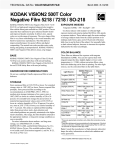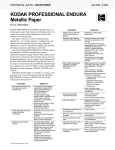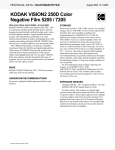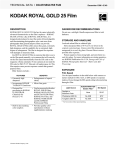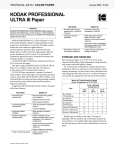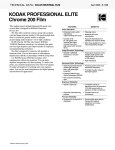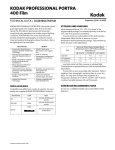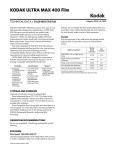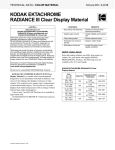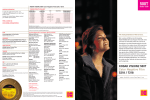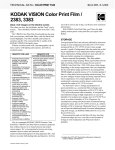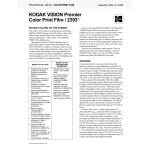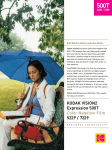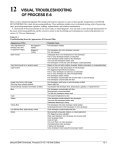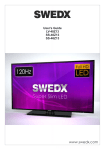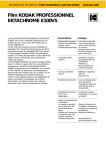Download Kodak EKTACHROME 7280 User's Manual
Transcript
May 2005 • H-1-7280t TECHNICAL DATA / COLOR REVERSAL FILM KODAK EKTACHROME 64T Color Reversal Film 7280 KODAK EKTACHROME 64T Color Reversal Film 7280 is a 64-speed color reversal motion picture camera film designed for exposure with tungsten illumination (3200 K). This film offers excellent color reproduction, fine grain, and high sharpness. 7280 has outstanding reciprocity characteristics, which give consistent color balance and speed over a wide range of exposures. EKTACHROME 64T Film should be processed in an E-6 Process. Manufacturing Code Size 7280 Super 8 Silent x 50 ft BASE KODAK EKTACHROME 64T Color Reversal Film 7280 has an acetate safety base. EXPOSURE INDEXES Tungsten (3200 K) - 64 / Daylight (5500 K) - 401 Use these indexes with incident- or reflected-light exposure meters and cameras marked for ISO or ASA speeds or exposure indexes. These indexes apply for meter readings of average subjects made from the camera position or for readings made from a gray card of 18-percent reflectance held close to and in front of the subject. For unusually lightor dark-colored subjects, decrease or increase the exposure indicated by the meter accordingly. COLOR BALANCE These films are balanced for exposure with tungsten illumination (3200 K). For other light sources, use the correction filters in the table below. Light Source KODAK Filters on Camera 1 Exposure Index Daylight (5500 K) WRATTEN Gelatin No. 85 40 Tungsten (3000 K) WRATTEN Gelatin No. 82B 40 None 64 DARKROOM RECOMMENDATIONS Do not use a safelight. Handle unprocessed film in total darkness. STORAGE Store unexposed film at 13°C (55°F) or lower. For extended storage, store at -18°C (0°F) or lower. Process exposed film promptly. Store processed film according to the recommendations in ANSI/PIMA IT9.11-1998: for medium-term storage (minimum of ten years), store at 10°C (50°F) or lower at a relative humidity of 20 to 30 percent; for extended-term storage (for preservation of material having permanent value), store at 2°C (35°F) or lower at a relative humidity of 20 to 30 percent. For active use, store at 25°C (77°F) or lower, at a relative humidity of 50 +/- 5 percent. This relates to optimized film handling rather than preservation; static, dust-attraction and curl-related problems are generally minimized at the higher relative humidity. After usage, the film should be returned to the appropriate medium- or long-term storage conditions as soon as possible. For more information about medium- and long-term storage, see ANSI/PIMA IT9.11-1998, SMPTE RP131-2002, and KODAK Publications No. H-1, KODAK Motion Picture Film available online at http:// www.kodak.com/US/en/motion/support/h1, and No. H-23, The Book of Film Care. Tungsten Photoflood (3400 K) Tungsten (3200 K) None 64 White-Flame Arcs WRATTEN Gelatin No. 85B 25 Yellow-Flame Arcs Color Compensating Filter 20Y 40 OPTIMA 32 None 64 VITALITE WRATTEN Gelatin No. 85 40 Fluorescent, Cool White WRATTEN Gelatin No. 85+ 10M 25 Fluorescent, Deluxe Cool White WRATTEN Gelatin No. 85C + 10R 40 Metal Halide (H.M.I.) WRATTEN Gelatin No. 85 40 1 These are approximate corrections only. Some light sources are extremely variable. For critical applications, light source color temperature should be verified and test exposures should be performed. Note: Consult the manufacturer of high-intensity ultraviolet lamps for safety information on ultraviolet radiation and ozone generation. 1.With a KODAK WRATTEN Gelatin Filter No.85. ©Eastman Kodak Company, 2005 RECIPROCITY CHARACTERISTICS CURVES You do not need to make any filter corrections or exposure adjustments for exposure times from 1/10,000 to 1 second. Sensitometric Curves PROCESSING -6 -8 4.0 Process this film in KODAK Chemicals, Process E-6, cine machine only. Camera Stops -2 0 2 4 6 Exposure: 3200 K Tungsten 1/10 sec Process: E-6 Densitometry: Status A B G R 3.0 -4 DENSITY IDENTIFICATION After processing, the product code number and other manufacturing identifications are visible along the length of the film. FILM-TO-VIDEO TRANSFERS 2.0 1.0 When you transfer the film directly to video, you can set up the telecine using the KODAK EKTACHROME Telecine Analysis Film (TAF) supplied by Eastman Kodak Company. The TAF consists of a neutral density scale and an eight-bar color test pattern with a LAD gray surround. The TAF gray scale provides the telecine operator (colorist) with an effective way to adjust subcarrier balance and to center the telecine controls before timing and transferring a film. The TAF color bars provide the utility of electronic color bars, even though they do not precisely match the electronically generated color bars. Using the TAF will help obtain optimum quality and consistency in the film-to-video transfer. For more information regarding TAF, see KODAK Publication No. H-822, KODAK Telecine Analysis Film User's Guide. 0.0 2.0 1.0 0.0 LOG EXPOSURE (lux-seconds) 1.0 2.0 The curves describe this film's response to red, green, and blue light. Sensitometric curves determine the change in density on the film for a given change in log exposure.2 Modulation-Transfer Function Curves 200 100 70 50 IMAGE STRUCTURE RESPONSE (%) 30 The modulation-transfer curves, and the diffuse rms granularity data were generated from samples of 7280 Film exposed with tungsten light filtered to 3200 K and processed as recommended in Process E-6 chemicals. R 7 5 3 2 Refer to curve. Read with a microdensitometer, (red, green, blue) using a 48-micrometre aperture. The "perception" of the graininess of any film is highly dependent on scene content, complexity, color, and density. Other factors, such as film age, processing, exposure conditions, and telecine transfer may also have significant effects. G 10 The "perceived" sharpness of any film depends on various components of the motion picture production system. The camera and projector lenses and film printers, among other factors, all play a role. But the specific sharpness of a film can be measured and charted in the Modulation Transfer Curve. rms Granularity: B 20 MTF: 2 3.0 4.0 TI2639AF 5-05 1 1 2 3 4 5 10 20 50 100 200 600 SPATIAL FREQUENCY (cycles/mm) TI2639B 5-05 This graph shows a measure of the visual sharpness of this film. The x-axis, "Spatial Frequency," refers to the number of sine waves per millimeter that can be resolved. The y-axis, "Response," corresponds to film sharpness. The longer and flatter the line, the more sine waves per millimeter that can be resolved with a high degree of sharpness—and, the sharper the film. KODAK EKTACHROME 64T Color Reversal Film 7280 • H-1-7280t Diffuse rms Granularity Curves Spectral Sensitivity Curves 10000 4.0 2.0 Process: E-6 Densitometry: Status A R 100 2.0 B G R 1.0 Granularity SIGMA D*1000 1000 3.0 DENSITY MagentaForming Layer LOG SENSITIVITY * G B 0.0 YellowForming Layer CyanForming Layer Effective Exposure: 1.4 sec Process: E-6 Densitometry: END Density: 1.0 -1.0 10 1.0 -2.0 250 300 350 400 450 500 550 600 650 700 750 WAVELENGTH (nm) 0.0 -3.0 TI2639C 5-05 -2.0 -1.0 Relative Log Exposure 2 1 0.0 To find the rms Granularity value for a given density, find the density on the left vertical scale and follow horizontally to the characteristic curve and then go vertically (up or down) to the granularity curve. At that point, follow horizontally to the Granularity Sigma D scale on the right. Read the number and multiply by 1000 for the rms value. *Sensitivity = reciprocal of exposure (erg/cm ) required to produce specified density TI2639D 5-05 These curves depict the sensitivity of this film to the spectrum of light. They are useful for determining, modifying, and optimizing exposure for blue- and green-screen special-effects work. Note: This curve represents granularity based on modified measuring techniques.2 2.NOTE: Sensitometric and Diffuse RMS Granularity curves are produced on different equipment. A slight variation in curve shape may be noticed. KODAK EKTACHROME 64T Color Reversal Film 7280 • H-1-7280t 3 Spectral Dye Density Curves 1.4 Normalized dyes to form a visual neutral density of 1.0 for a viewing illuminant of 5000K. Process: E-6 Visual Neutral DIFFUSE SPECTRAL DENSITY 1.2 1.0 0.8 Cyan Yellow Magenta 0.6 0.4 0.2 0.0 400 TI2639E 5-05 500 600 700 WAVELENGTH (nm) These curves depict the spectral absorptions of the dyes formed when the film is processed. They are useful for adjusting or optimizing any device that scans or prints the film. Note: Cyan, Magenta, and Yellow Dye Curves are peak-normalized. NOTICE: The sensitometric curves and data in this publication represent product tested under the conditions of exposure and processing specified. They are representative of production coatings, and therefore do not apply directly to a particular box or roll of photographic material. They do not represent standards or specifications that must be met by Eastman Kodak Company. The company reserves the right to change and improve product characteristics at any time. SIZES AVAILABLE Standard Products Available 4 Identification No. Length in Metres (Feet) Core Description Perforations Super 8 SP464 15 (50) Super 8 cartridge Winding B For super 8 cartridge cameras 8 1R-S1667 KODAK EKTACHROME 64T Color Reversal Film 7280 • H-1-7280t MORE INFORMATION Outside the United States and Canada, please contact your Kodak representative. You can also visit our web site at www.kodak.com/go/motion for further information. You may want to bookmark our location so you can find us easily the next time. Films Cinematographer’s Field Guide KODAK Publication No. H-2 Image Structure KODAK Motion Picture Film KODAK Publication No. H-1 Specification Numbers Cinematographer’s Field Guide KODAK Publication No. H-2 Storage KODAK Motion Picture Film KODAK Publication No. H-1 The Book of Film Care KODAK Publication No. H-23 LAD LAD—Laboratory Aim Density KODAK Publication No. H-61 Transfer KODAK Telecine Analysis Film User’s Guide KODAK Publication No. H-822 KODAK Telecine Exposure Calibration Film User’s Guide KODAK Publication No. H-807 KODAK EKTACHROME 64T Color Reversal Film 7280 • H-1-7280t 5 KODAK EKTACHROME 64T Color Reversal Film 7280 Kodak Locations FOR DIRECT ORDERING IN THE UNITED STATES AND CANADA: 1-800-621-FILM CHICAGO, ILLINOIS Information: 630-910-4929 DALLAS, TEXAS Information: 972-346-2979 HOLLYWOOD, CALIFORNIA 6700 Santa Monica Boulevard Los Angeles, California 90038-1203 Information: 323-464-6131 NEW YORK, NEW YORK 360 West 31st Street New York, New York 10001-2727 Information: 212-631-3418 LATIN AMERICA REGION 8600 NW 17th Street Suite 200 Miami, Florida 33126-1006 Phone: 305-507-5146 VERDUN, QUEBEC Kodak Canada, Inc. 4 Place du Commerce, Suite 100 Ile des Soeurs Verdun, Quebec Canada H3E 1J4 Information: 514-761-7001 Fax: 514-768-1563 Orders: 1-800-621-FILM (3456) Fax Orders: 1-866-211-6311 TORONTO, ONTARIO Kodak Canada Inc. 3500 Eglinton Avenue West Toronto, Ontario Canada M6M 1V3 1-800-621-FILM (3456) BURNABY, BRITISH COLUMBIA Kodak Canada, Inc. 4185 Still Creek Drive Suite C150 Burnaby, British Columbia Canada V5C 6G9 Tel: 1-800-621-FILM (3456) EUROPEAN, AFRICAN, AND ME REGION Eastman Kodak Company Kodak Ltd. Kodak House Hemel Hempstead Herts, HP1 1JU England Local: 01442-845-945 Fax: 01442-844-458 Eastman Kodak SA 29-31 Route de l'aeroport Case postale 271 Le grand Sacconex, 1215 Geneve 15 Information: +41-22-747-2000 Fax: +41-22-747-2200 ASIA PACIFIC REGION AUSTRALIA Melbourne: 613-9353-2561 Toll free: 1-800-337-935 CHINA (Peoples Republic) Beijing: 8610-6561-6561 Shanghai: 8621-6350-0888 Guangzhou: 8620-8319-8888 HONG KONG Tel: 852-2564-9352 INDIA 91-22-652-6826 INDONESIA 62-21-570-5212 JAPAN 81-3-5644-5348 KOREA 82-2-708-5561 MALAYSIA 60-3-757-2722 NEW ZEALAND 64-9-302-8665 PAKISTAN 92-21-561-0150 PHILIPPINES 632-810-0331 SINGAPORE 65-476-9688 TAIWAN 886-2-2893-8108 THAILAND 66-2-271-3040 Ext. 310 KODAK EKTACHROME 64T Color Reversal Film 7280 KODAK Publication No. H-1-7280t Kodak, Ektachrome, Vision, and Wratten are trademarks. New 5-05 Printed in U.S.A.






